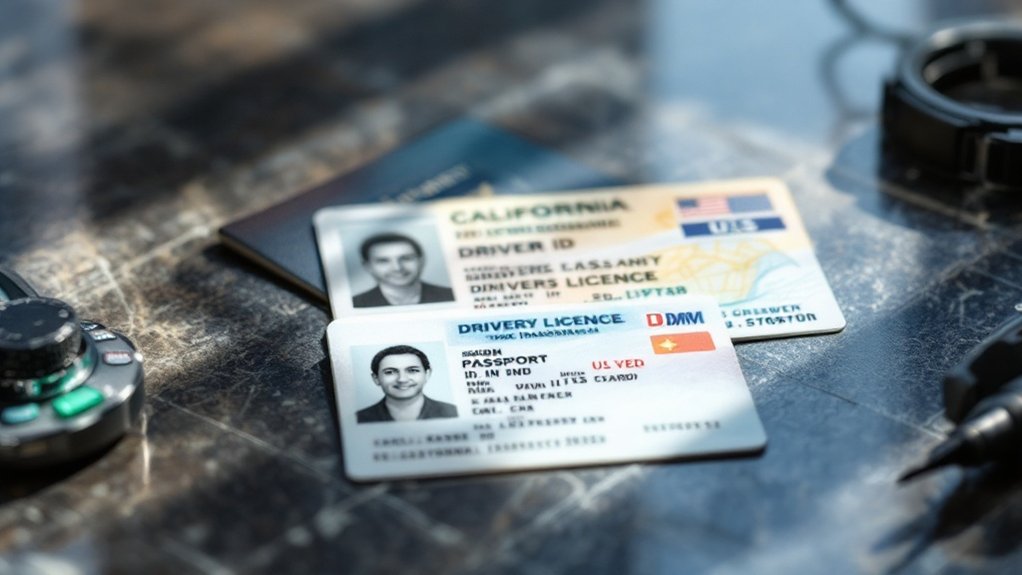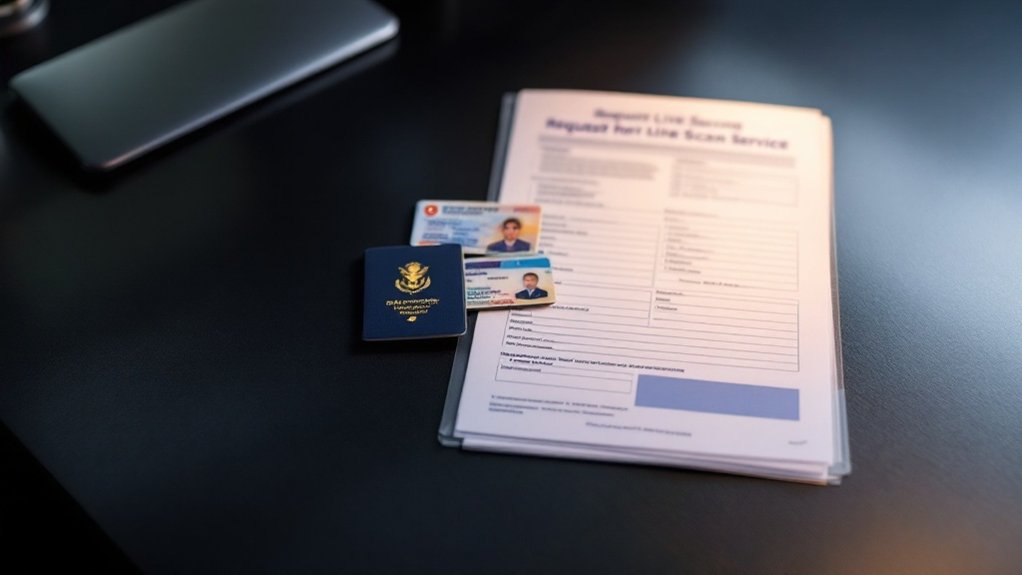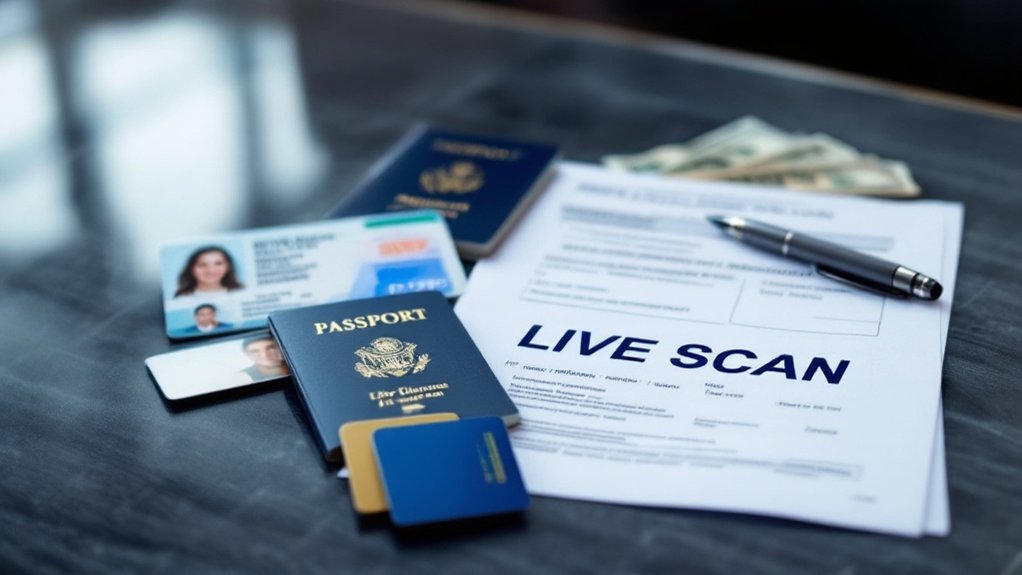When you undergo Live Scan fingerprinting, you’ll need a primary ID like a state-issued driver’s license or U.S. Passport. If you lack a primary ID, secondary documents such as a birth certificate or Social Security Card can be used, but they require additional supporting documents. Verify your ID is valid and includes your current photo and address. For more detailed requirements and the process, you can explore further to understand the efficiency and benefits of Live Scan technology.
Primary Forms of Identification

When preparing for a Live Scan fingerprinting appointment, you’ll need to bring a valid primary form of identification. Common primary IDs include a state-issued driver’s license, a U.S. Passport or U.S. Passport Card, and a Federal Government Personal Identity Verification Card (PIV). Military personnel can use a Uniformed Services Identification Card or a Department of Defense Common Access Card. Additionally, a Foreign Passport with appropriate immigration documents, a Permanent Resident Card (I-551), and an Employment Authorization Card (I-766) are also accepted. These documents must be valid and match your current name and date of birth.
Secondary Forms of Identification
When undergoing live scan fingerprinting, you will need to provide secondary forms of identification if you lack a primary form. Secondary identification documents include a state government-issued certificate of birth, a U.S. Active Duty/Retiree/Reservist Military ID Card, a passport from any country, a Social Security Card, and a Certificate of Citizenship (N560). Additionally, you may use other documents like a Certificate of Naturalization, INS I-551 Resident Alien Card, or a U.S. Tribal or Bureau of Indian Affairs Identification Card, often requiring supporting documents such as utility bills or voter registration cards to validate your identity. Fingerprinting is crucial for law enforcement as it provides proof of identity, which is essential for ensuring accurate background checks and maintaining public safety.
Secondary Forms of Identification
Secondary forms of identification are crucial for individuals who do not possess a primary form of photo identification, such as a driver’s license or state ID. These documents help verify identity and can include military IDs, U.S. passports, and federal government-issued Personal Identity Verification Cards. Government-issued secondary IDs like Social Security cards and marriage certificates are also used. Immigration documents, such as naturalization certificates and resident alien cards, serve similar purposes. Additionally, utility bills and vehicle registrations can be used to validate addresses and identities. These documents are indispensable for various administrative and legal processes. For individuals undergoing Live Scan fingerprinting, it is essential to have at least one valid government-issued photo ID, such as a driver’s license, to ensure a smooth process.
Birth Certificates
Birth certificates serve as essential secondary forms of identification, particularly for minors under 16 years old who lack a primary photo ID. They verify a minor’s identity when accompanied by a parent or legal guardian with a valid primary ID. In California, birth certificates are used in specific circumstances, such as Live Scan fingerprinting for minors.
Here are key considerations:
- Verification Process: Live Scan operators verify birth certificate information against other documents.
- Age Limitation: This option is primarily for individuals under 16.
- Documentation Accuracy: Birth certificates must be valid and government-issued to avoid processing issues.
Tribal IDs
As you explore various forms of identification for Live Scan fingerprinting, you might be interested in how tribal IDs fit into this process. Native American Tribal ID Cards are recognized as primary forms of identification, similar to driver’s licenses or passports. They are not typically listed as secondary forms of identification. State-specific regulations may vary in accepting tribal IDs for different purposes. When using tribal IDs for fingerprinting, it is crucial to understand that they are considered primary identification. Tribes have their own methods for conducting background checks, which may involve fingerprinting through state or federal channels. The Department of Justice’s Tribal Access Program facilitates access to federal databases for tribes. Additionally, all Level 2 screening requests must be submitted electronically to ensure compliance with the required protocols.
ID Requirements for Live Scan Fingerprinting

When you prepare for a Live Scan fingerprinting appointment, you will need to bring a valid primary form of identification, such as a state-issued driver’s license or U.S. passport. A secondary form of ID, like a utility bill or Social Security card, may also be required to verify your address or other details. Guarantee that your IDs match your current name and date of birth, as these must be consistent for the process to proceed. Additionally, Live Scan fingerprinting is a digital process that captures fingerprints electronically using a digital scanner, ensuring accuracy and efficiency in background checks.
Primary ID
To undergo Live Scan fingerprinting, you must present a valid government-issued photo identification. This ascertains that your identity is verified accurately and securely. The primary IDs accepted include driver’s licenses, U.S. passports, military IDs, and permanent resident cards.
- Accuracy and Validity: Confirm your ID is unexpired and matches your current name and date of birth.
- Photo Verification: The photo on your ID must reasonably resemble you.
- Liability Protection: Using invalid IDs can place liability on the Live Scan agency, so it’s essential to verify their authenticity.
Secondary ID
In the absence of a primary form of identification, you can use secondary IDs for Live Scan fingerprinting. Acceptable secondary IDs include a state government-issued certificate of birth, U.S. Active Duty/Retiree/Reservist Military ID Card, passport from any country, and Social Security Card. Additionally, certificates of citizenship or naturalization are valid options.
To support your secondary ID, you will need at least two documents such as a utility bill, voter registration card, vehicle registration, paycheck stub, or a cancelled check. Other secondary IDs include a PIV card, Department of Defense Common Access Card, and foreign passports with appropriate immigration documents. Live Scan fingerprinting is a completely electronic process, which ensures that all submissions are handled efficiently and without the need for physical ink-based prints.
Live Scan Fingerprinting Process
Live scan fingerprinting is a modern, digital process used for background checks, employment screening, and certification, offering a more efficient and accurate alternative to traditional ink-based methods. It involves electronically capturing fingerprints using a specialized scanner, which are then transmitted to the appropriate agency for processing.
Here are some key aspects of the process:
- Efficiency: Results are typically faster than traditional methods.
- Accuracy: Digital scans reduce errors associated with ink smudges.
- Convenience: The process is non-invasive and eliminates the need for physical fingerprint cards. You will need to bring a valid ID and complete a request form to participate in the process.
The California DOJ developed Live Scan, which has become widely adopted due to its ability to provide quick and accurate fingerprinting results.
Fees Associated With Live Scan Fingerprinting

When you undergo Live Scan fingerprinting, you’ll encounter several types of fees that contribute to the overall cost. Service fees typically range from $20 to $50, depending on the provider. The California Department of Justice (DOJ) charges about $32 for state-level checks, while the Federal Bureau of Investigation (FBI) charges $17 for federal checks. Additional fees may apply based on the application type.
Your total cost will vary based on the specific requirements of your application. For example, a Certified Nurses Assistant pays $52, including a $20 service fee and $32 DOJ fee. Some agencies have billing arrangements that may reduce your costs. The total cost can range from $50 to $100, depending on whether you need both state and federal background checks, which often involve a Live Scan service fee.
Benefits and Applications of Live Scan Fingerprinting**
After understanding the fees associated with Live Scan fingerprinting, it’s clear that the benefits and applications of this technology far outweigh its costs. You benefit from accurate and reliable fingerprint records, faster processing times, and a cleaner, more convenient experience. Live Scan is widely used for background checks, immigration, and law enforcement.
- Guaranteed Accuracy: Reduces human error and guarantees precise fingerprint capture.
- Efficient Processing: Results are transmitted electronically in seconds.
- Convenience: Eliminates messy ink and smudging issues, making it a preferred choice for many.
Additionally, Live Scan fingerprinting allows for the retaking of prints, ensuring that the best possible image quality is captured, which further enhances its reliability and efficiency in various applications.
Conclusion
In guaranteeing seamless Live Scan fingerprinting, you must bring the right ID. Primary forms include driver’s licenses and passports, while secondary forms may include utility bills or social security cards. The process involves capturing fingerprints and submitting them for background checks. Fees vary by provider. As the adage goes, “an ounce of prevention is worth a pound of cure,” so verifying requirements beforehand is vital. This certifies a hassle-free experience.

